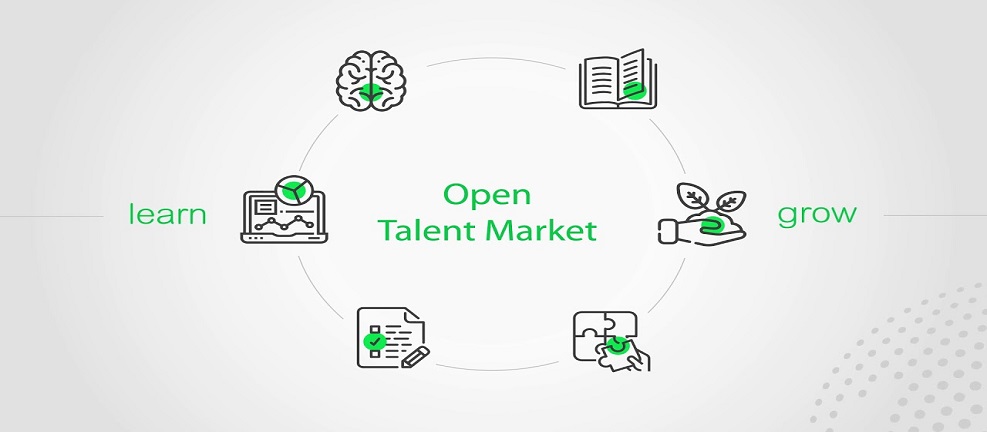The way we used to think how a perfect workforce would be formed is no more the same with the global talent economy model emerging, compelling businesses to rethink, reconsider, and reshift their hiring and retention processes. Till now, businesses knew what roles they would need to fill and where and how they could find the talent to fill those talent requirements. The employees used to come to the company building in the morning and leave at the end of the day, where the business owners and managers could see and interact with each other.
Things are changing now. More businesses and talents are shifting from traditional full-time jobs to more flexible freelancing and contract jobs or hybrid forms, allowing the workforce to work from anywhere and businesses to source talent from anywhere on the globe. In the following sections of this blog, we will discuss what is open talent economy and what are its benefits for businesses in embracing this model - an evolving hiring model that enables open talent sourcing practices.
What is Open Talent Model?
Organizations have begun re-imagining how their workforce should be structured in order to remain efficient and competitive. The definition of the workforce is changing, bringing the working relation to equal terms for both employees and employers. The workforce will be evolving to be a blend of traditional full-time employees, contractors, gig workers, and freelancers, who work across business operations and regions. In other words, this is a work culture that challenges the traditional hiring and retention strategies that have been in existence during the 20th and early 21st centuries.
The emergence of remote working, developments in technology, and the impacts of globalization are the key driving factors behind the advent of open talent economy. According to Deloitte, the trend is in its early stages of evolvement and is likely to be the future way of sourcing talents for companies to remain efficient and competitive. The model is about organizations leveraging contractors, freelancers, partnerships, or open-sourced talent to meet their talent requirements on an on-demand basis. This trend will ultimately transform the meaning of the term “workforce”, from what we believe now.
What’s Driving The Open Talent Economy?
The shifts driving the open talent economy are visible across the world and in every industry and segment. They are essentially changing the structure of how talent is hired and how the workforce delivers. The factors that are driving the change include:
Globalization: The emergence of a global talent market across multiple fields and domains is opening up new ways of sourcing, developing, and managing talent for businesses to get their tasks and projects completed.
Technology: Open talent economy works on technology, that allows people to learn, collaborate, and work from anywhere in the world, challenging the traditional talent acquisition models. The improved computing speed, enhanced storage facilities, and innovative digital tools make real-time collaboration from anywhere possible in almost every area.
Mobility: Social mobility coupled with technology frees up talent from the constraints of physical geography and specified markets. It enables critical talent to work anywhere of their choice and allows career changes more seamlessly and frequently.
Social Collaboration: The open talent economy is an open-source app, shifting focus from the traditional organization to dynamic social networks. Organizations have begun to use social media to connect and deploy people in various ways across the globe.
Advantages and Disadvantages of the Open Talent Model
The new talent model of sourcing talents in the marketplace offers businesses several benefits that include:
- Allows companies easy access to niche skillsets that may not be available within their internal teams and beyond the reach of small and medium businesses
- Enables companies to scale up or scale down their talent demands instantly depending on the market conditions and changes
- Project-based teams are likely to be more productive with faster turnaround times compared to an internal team
- It is more cost-effective because of not having to recruit and commit on a full-time basis and as well the availability of specialized talents at lower cost
- It allows companies to start, pause, or end the contracts as needed
It also comes with disadvantages that need to be managed well to gain the benefits of the model, including:
- Some projects may not be feasible with an open talent model
- Organizations may encounter statutory and labor law compliance issues depending on the country of business or the employee
- Hiring through talent marketplaces can sometimes be tedious and time-consuming
- It can sometimes cause security risks, as well as conflicts with full-time payroll employees
- Recruiters may find it difficult to identify fake candidates being the entire hiring processes are virtual
Adapting to the New Model
It is inevitable to rethink the labor supply chain where an always-on workforce can be scaled up or down as the company needs at any time. In addition, in an open economy, the priorities of the employees can be drastically different from traditional models. What motivates the employees can be the pay, flexibility, and freedom over fancy buildings or the company’s employee policies which are irrelevant to contractors and freelancers.
Organizations shifting to the open talent model must be able to understand the job market well and design the skill and career development, and compensation and rewards to meet the expectations of the open model workers in their talent ecosystems. It is crucial for companies to build and retain talent networks and talent partners that can provide the right talent at the right time in the right numbers. This will involve adopting combinations of talent hiring models, branding, and technology.
Final Note
If you are conscious of the cost disadvantages and the constraints faced by small to medium organizations in hiring full-time top talents, you would want to mix your company’s workforce to include contractors or freelancers to supplement your regular team, then AiDoos provides an open talent marketplace to recruit individual talent or a team to manage your tasks or projects.
An increasing number of companies are embracing project-based work models that consider trends in sectors as diverse as information technology, media, entertainment, and advertising on the one hand and infrastructure and construction on the other. As companies evolve their hiring practice toward these models, new talent-sourcing networks and relationships will emerge among companies and workers.




